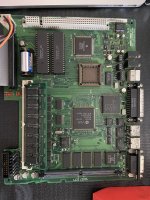When I did my IIci, I was out of SMD electrolytics of the correct values, so I just cut the leads on through-hole electrolytics really short and soldered them to the pads. It actually worked far better than I expected, and I think I'm going to just leave it that way until they start failing (I used cheapo chinese caps, since I expected it to just be a temporary experiment and wanted to use them up). I generally prefer Panasonic, and that's what I'll probably use next time, being afraid that I'll just have the same trouble in another 30 years if I use the "correct" SMD electrolytics, but any quality brand Japanese, American, or European capacitors ought to last just fine (and that should apply to SMD capacitors, too).
One thing that I *am* suspicious of is when people replace SMD electrolytics with tantalums. When electrolytics fail, they fail open, and the circuit is (hopefully) designed with that in mind. When tantalums fail, they fail *closed*, and again the circuit is (hopefully) designed with that in mind. But with the recent popularity of recapping with tantalums "because they don't leak", I think we're going to see the magic smoke coming out of a lot of boxen 30 years from now when those tantalums start failing. Best case it'll keep PSUs from powering up, but worst case it might burn traces on motherboards, which would be really unfortunate.


